Full STEAM ahead!
Our June Members' Meeting took place on 16 June 2021 and focused on the use of heritage science to engage with children of school age.
The meeting brought together best practice and learning from across NHSF's membership and invited participants to take part in a discussion about how we can increase and maximise opportunities to support national curricula across the UK, as well as wider learning, with heritage science.
Dr. Paola Ricciardi (University of Cambridge) welcomed everyone to the session and explained its role in part of a programme of activity by the NHSF Communities working group. The group is working towards the long-term goal of a skilled and diverse heritage science community (part of the Strategic Framework for Heritage Science in the UK). To develop this community we recognise that we need to create opportunities to hear and learn about heritage science early in people's lives - for example, in the classroom at school age, or as part of extra curricula activities. Heritage science not only provides opportunities to develop scientific skills but also to learn about history and heritage through science. The NHSF group wants to develop and then run a funded project that enhances curriculum mapping, develops targeted teaching and learning resources stemming from heritage science research, and work with partners to share those resources through established programmes. The discussion and ideas generated by this workshop will feed into that ambition.
Presentation: Welcome and background to session (pdf)
Professor Pamela Burnard (University of Cambridge) delivered a keynote lecture titled What if sciences were arts all along? New sites of attention and inseparability
Prof. Burnard's keynote provocation encouraged us to think about STEAM differently and to expand, conceptually, ways of working across the science and arts. She advocated 'de-territorialising' disciplines and thinking afresh about what our practise as heritage scientists can achieve, reimagining different collective futures and positioning STEAM in future-making, in transdisciplinary education and as a means of creating new knowledge.
Presentation: What if sciences were arts all along? New sites of attention and inseparability (pdf)
Attendees were then encouraged to discuss challenges and opportunities, and asked to think about how the collections and heritage sites we care for can provide exciting ways to engage with school-age children and their teachers, and support schools in delivering curriculum targets.
You can see their thoughts in the images below.
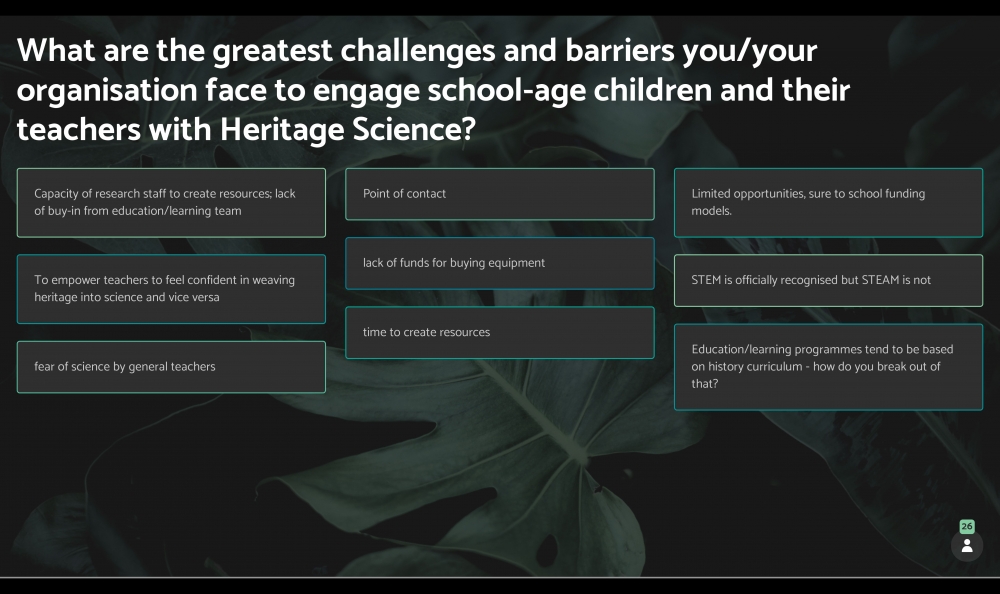
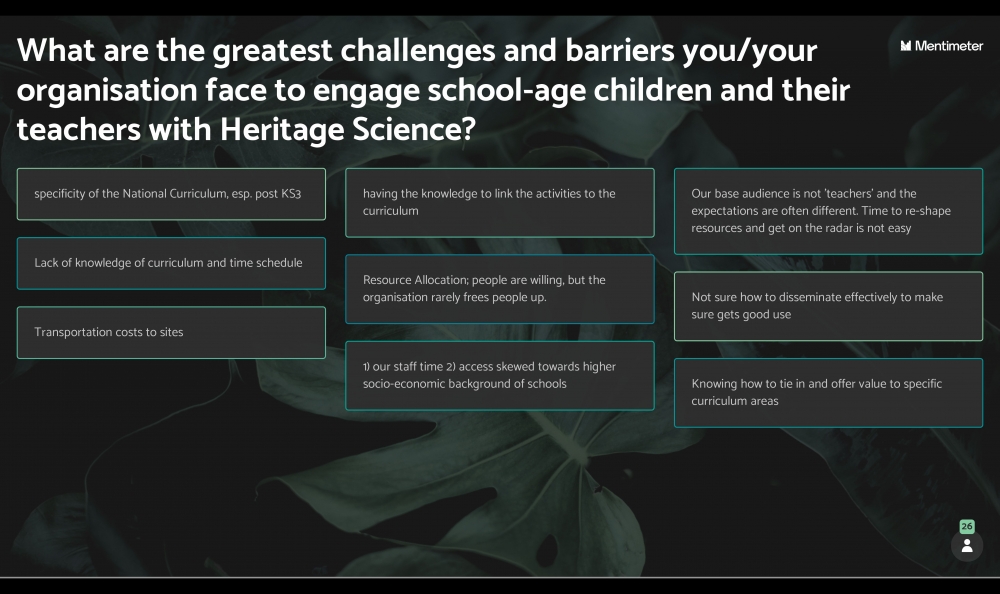
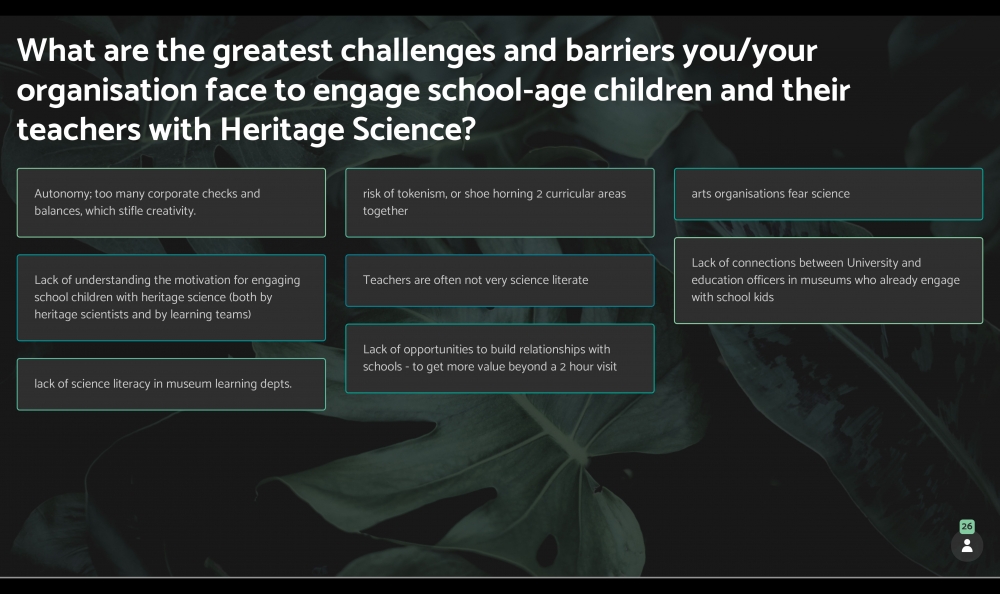
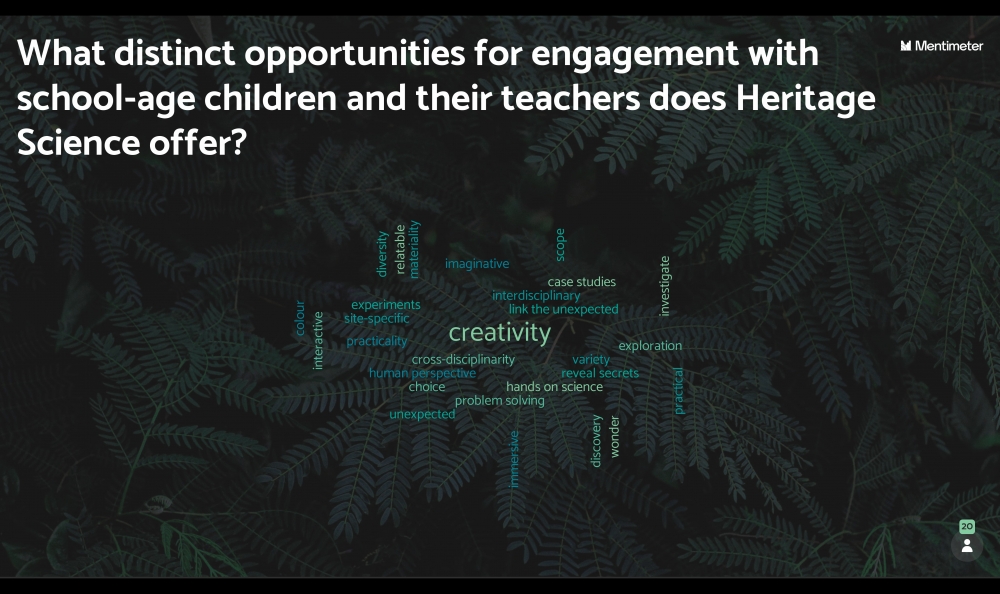
Three talks then highlighted best practice in schools-focused engagement, drawn from the NHSF membership.
Natalie Brown and Emily Morris (The National Archives) - Creating educational resources for British Science Week: an opportunity to collaborate
Natalie and Emily shared an example of how they had worked together to create science-based resources as part of British Science Week 2021. The collaboration was the first time that heritage science had been used to support The National Archives' learning and outreach activities, which are normally linked to the history curriculum.
Dr Alex Ball (Natural History Museum) - Design Consideration for 3D printed models for engagement with the visually impaired
Alex's presentation provided an innovative example of applying heritage science to support the learning of school-age children. His work involved investigating how 3D printing could be used to 'replicate' microscopic objects. The presentation spanned issues of design standards, practical considerations when producing reproductions and specific learning from working with blind and visually impaired people.
Presentation: Design consideration for 3D printed models for enagement with the visually impaired (pdf)
Brian Wilkinson (The Engine Shed, Historic Environment Scotland) - Bridging the curriculum
Brian's presentation shared information on how the team at The Engine Shed (Historic Environment Scotland) approaches the development of its school programmes. Using an example based on the topic of bridges, Brian explained how their programmes align to the Curriculm for Excellence, and the experiences and outcomes that are set out as part of that curriculum. The content developed at The Engine Shed is pitched at age-appropriate level with an emphasis on supporting STEM-based learning. Their approach is to use their strengths at The Engine Shed to add value and support to teachers, generating activities that go beyond what can be offered in a classroom setting.
Presentation: Bridging the curriculum (pdf)
In the final part of the event, attendees split into four breakout groups and each discussed one of four questions:
- What support would you need to create Heritage Science learning and development resources for school children and their teachers?
- Thinking about your collections, heritage sites, and/or heritage science expertise, what kind of topics can you think of which would be relevant to the school curriculum targets?
- Which engagement methods offer the best potential for maximum reach and impact?
- Which dissemination channels and delivery partners are most effective for schools-focussed outreach activities?
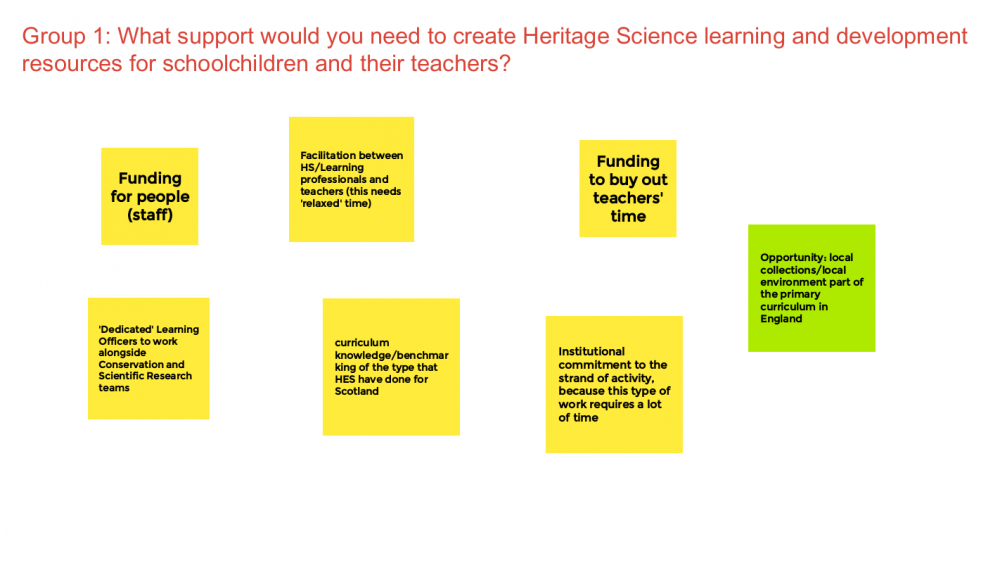
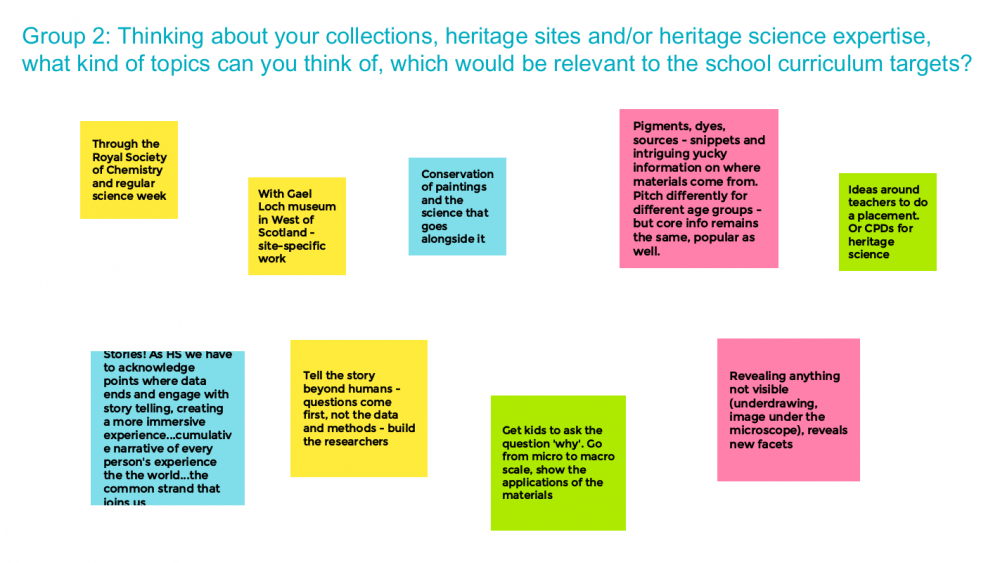
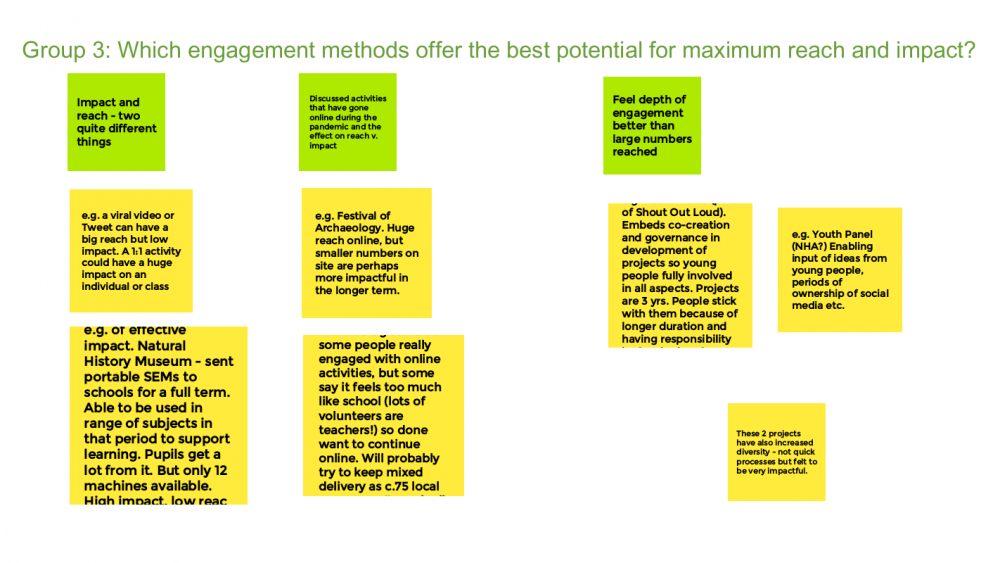
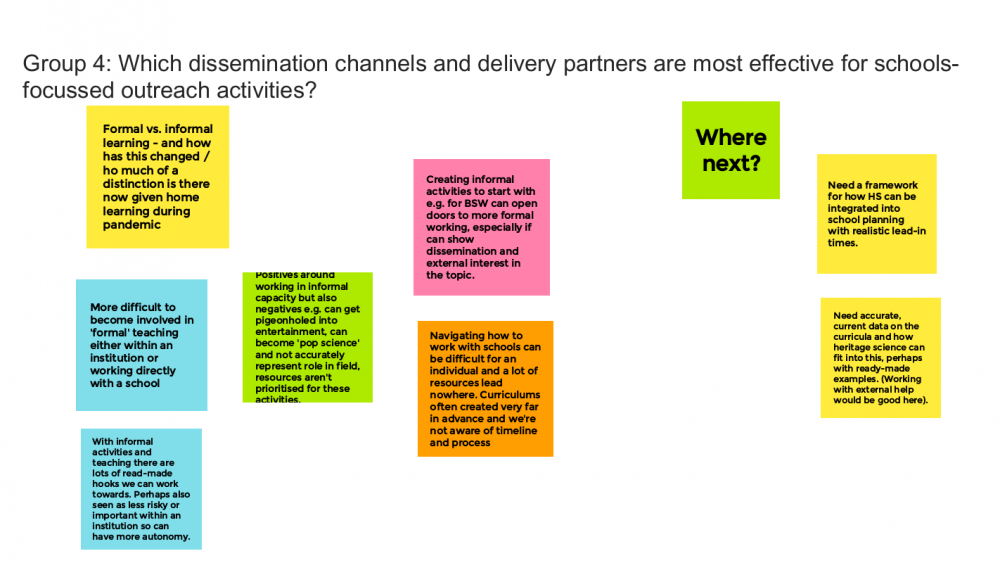
About our speakers
Pamela Burnard is Professor of Arts, Creativities and Educations at the Faculty of Education, University of Cambridge where she Chairs the Arts and Creativities Research Group and runs an online monthly seminar series called ‘Performing Research’. She has published widely with 20 books and over 100 articles which advance the theory of multiple creativities across education sectors including early years, primary, secondary, further and higher education, through to creative and cultural industries. She is co-editor of the journal Thinking Skills and Creativity. Current funded projects include ‘Choices, Chances and Transitions around Creative Further and Higher Education’; ‘Diversifying Compositional Creativity using AI’; ‘Sculpting New Creativities in Primary Education’; and a meta-analysis of the culminative impact of ‘Contemporary Urban Musics for Inclusion Networks’ (CUMIN). She is a Fellow of the Royal Society of Arts (RSA) and the Chartered College of Teaching, UK.
Natalie Brown is the Senior Conservation Manager – Engagement at The National Archives. In her role she leads on disseminating heritage science research and conservation practice happening within the organisation as well as developing and managing programmes of public, education and academic engagement. Prior to joining The National Archives, Natalie worked for the European Research Infrastructure for Heritage Science where she led the UK hub’s communication activities. Natalie trained as a paper conservator and heritage scientist, and is currently completing her PhD at the Institute for Sustainable Heritage, University College London.
Emily Morris is the Family and Young Person’s Programme Officer at The National Archives. Working in the Education and Outreach department, Emily designs and delivers learning activities and projects for families and young people. The programmes aim to engage non-traditional audiences with archive documents in creative and exciting ways. Recent examples of work include ‘From Outbreak to Archive’ – a young person’s online animation film project, engaging 15 young people with documents on disease and public health from the collection. For families in the Time Travel Club, Emily has been running online sensory storytelling for children under-3 with a professional storyteller.
Dr Alex Ball is Head of Imaging and Analysis at the Natural History Museum in London. He has used a wide variety of equipment for STEM events and currently manages a portable SEM loan scheme for schools as part of Hitachi High-Tech America’s STEM Educational Outreach Programme. A key and lasting motif has been to demonstrate the visual impact of high-performance imaging systems. However, the one group that are unable to appreciate these microscopical marvels are the visually impaired. With the discovery that SEMs can generate 3D models using photogrammetry, Alex secured funding from Zeiss and the EPSRC to fund research into how microscopical features can be modelled in 3D for science engagement with the visually impaired.
Brian Wilkinson is Activities Manager at The Engine Shed, Historic Environment Scotland’s Building Conservation Centre, where he leads the Activities Team. They are responsible for helping schools and their visitors find out about Scotland’s Traditional Buildings, Materials and Skills. Over the years Brian has carried out learning roles for a variety of heritage organisations including council museum services, National Museum Scotland, The Royal Commission on the Ancient and Historical Monuments of Scotland, and The National Trust for Scotland. He has undertaken freelance work making educational resources and activities for heritage bodies such as Archaeology Scotland and Forestry Commission Scotland.
